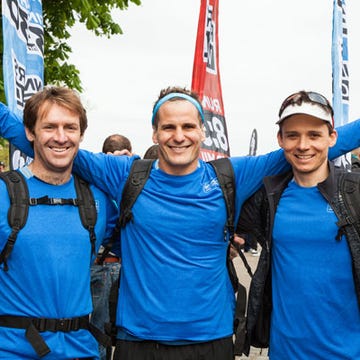This content has been created in collaboration with New Balance.
It happens to even the best runners. Halfway through a half-marathon, your eyes lock onto the back of a neon-clad adversary. He is your target. Your motivation. You are going to defeat him.
He’s also, it turns out, incredibly fast – and attempting to match his pace leaves you panting and miserable while your better-prepared opponent speeds away.
Beware of your competitive instinct. Keeping track of your pace is one of the most important running skills to master, and one of the most overlooked. We asked PT and New Balance Running out of steam? Preparation and mental strength is key to creating the perfect pacing strategy (@bencamara) You are your toughest opponent.
Prepare for victory
Self knowledge is power. “My running pace is perfected during training,” says Ben. You can calculate the perfect pace for any race simply by undertaking a ‘magic mile’ time trial close to race day.
Pick a flat stretch of terrain a mile long and, after a brief warm up, push yourself to run the distance at a hard pace. Not as fast as you can. Just so you’re seriously panting at the end. Note what you clock in at. This ‘magic mile’ time can be used to calculate the perfect pace per mile for any distance. Simply add 33 seconds per mile for the correct 5k pace, or multiply by 1.15 for a 10k, 1.2 for a half marathon and 1.3 for a marathon.
“On the day of the event, the adrenaline takes over,” says Ben. It’ll push you further, but you need to make sure the rush isn’t forcing you to set off too fast. And don’t get dragged along by anyone either – especially a show off in neon. If you’ve perfected your pace in training, there’s no need to worry; the hardest part’s over. Stick to the magic mile formula and you’ll do yourself proud.
Tech tonics
If you’re not keeping tabs on your timings and your body, you’re running blind. A simple running app with GPS will allow you to gauge your time every mile and ensure you’re keeping to the correct pace. For races that don’t allow headphones, simply use a stopwatch on your wrist, or clamp your phone to your tricep with a strap, and clock in at every mile marker.
Ben also recommends using a heart rate monitor. “This can help you gauge where your body is in relation to where it needs to be,” he says. If you start to stray into a very high heart rate, no matter what your magic mile pace demands, slowly ease off a little to take the strain off your ticker.
Nerves can derail even the best laid pacing plans. But if you put in the hours in training you should be able to master your mind and your body and finish as strong as you start. One last thing. Sprint finishes might make you feel like you’re in a movie, but the best running coaches will tell you the perfect race is run at the exact same pace from start to finish. If you’ve enough left in the tank for a 200m tape-busting sprint, you were going too slow, champ. Enjoy the glory – but up your pace a little next time…
New Balance Toughest Opponent is a story about the battles we have within ourselves. The niggling mind games that play out between our ears that make us question whether to run that extra mile, to lift that heavier weight, or to go forward and push harder, faster and stronger than we did the day before. Find out more at: http://www.newbalance.co.uk/TougestOpponent.
We earn a commission for products purchased through some links in this article.







